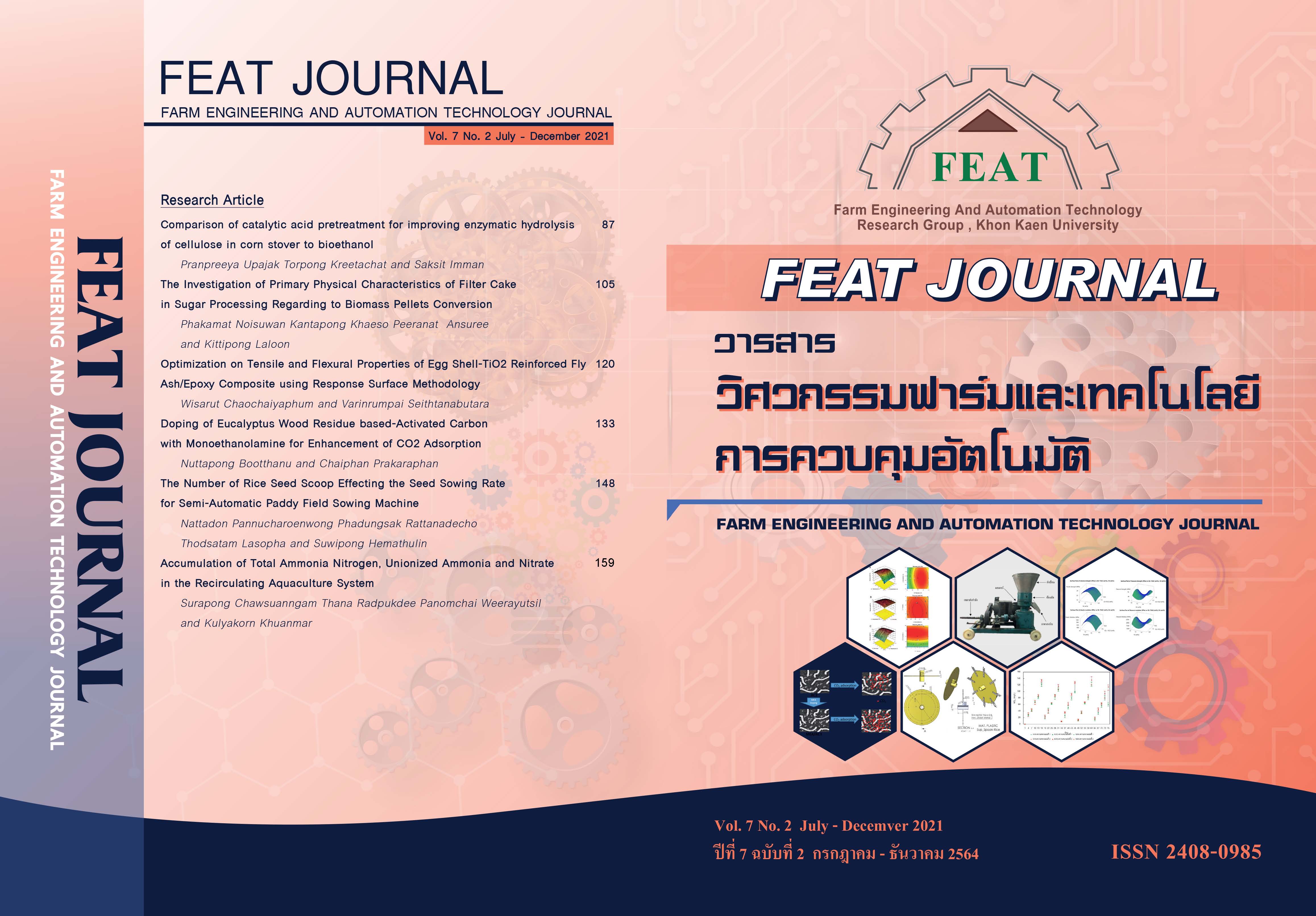การเจือถ่านกัมมันต์เศษไม้ยูคาลิปตัสด้วยโมโนเอทาโนลามีนเพื่อเพิ่มความสามารถในการดูดซับก๊าซคาร์บอนไดออกไซด์
Main Article Content
บทคัดย่อ
การศึกษานี้ได้มุ่งพัฒนาตัวดูดซับก๊าซคาร์บอนไดออกไซด์จากกากชีวมวล โดยการนำเศษไม้ยูคาลิปตัส ปริมาณ 20 กรัม มาแช่กระตุ้นภายใต้คลื่นอัลตร้าโซนิคในสารละลายกรดฟอสฟอริคความเข้มข้น 3 และ 6 โมลาร์ ปริมาตร 160 มิลลิลิตร เป็นเวลา 45 นาที แล้วนำไปคาร์บอนไนเซชันที่ 450 องศาเซลเซียส เป็นเวลา 1 ชั่วโมง ภายใต้บรรยากาศก๊าซเฉื่อย พบว่า ถ่านกัมมันต์ที่ได้จากการกระตุ้นด้วยกรดฟอสฟอริคความเข้มข้น 3 โมลาร์ มีพื้นที่ผิวจำเพาะสูงถึง 1,330 ตารางเมตรต่อกรัม และมีโครงสร้างรูพรุนขนาดกลางเป็นส่วนใหญ่ ดังนั้นถ่านกัมมันต์นี้จึงได้ถูกคัดเลือกมาพัฒนาใช้เป็นตัวดูดซับโดยนำมาเจือสารโมโนเอทาโนลามีนที่ความเข้มข้น 10-50 เปอร์เซ็นต์โดยน้ำหนัก ทั้งนี้ได้มีการเปรียบเทียบผลของวิธีการสองแบบ คือ วิธีการเจือแบบการต้มเคี่ยวด้วยเพลทให้ความร้อน และวิธีการเจือแบบแช่ผสมเขย่าร่วมคลื่นอัลตร้าโซนิค ที่มีต่อสมบัติของตัวดูดซับ พบว่า ตัวดูดซับมีพื้นที่ผิวจำเพาะ ขนาดรูพรุน และ ปริมาตรรูพรุนรวม มีค่าลดลงตามความเข้มข้นของสารเจือ ทั้งนี้ การใช้วิธีการเจือแบบแช่ผสมเขย่าร่วมคลื่นอัลตร้าโซนิคให้ผลของการลดลงสมบัติเหล่านี้น้อยกว่าวิธีการเจือแบบต้มให้ความร้อน ตัวดูดซับที่มีความสามารถในการดูดซับก๊าซคาร์บอนไดออกไซด์มากที่สุด คือตัวดูดซับที่ได้จากการเจือสารโมโนเอทาโนลามีนความเข้มข้น 10 เปอร์เซ็นต์โดยน้ำหนัก ด้วยการใช้วิธีการเจือแบบแช่ผสมเขย่าร่วมคลื่นอัลตร้าโซนิคให้ค่าเป็น 59.67 มิลลิโมลต่อกรัม
Article Details
วารสารวิศวกรรมฟาร์มและเทคโนโลยีควบคุมอัตโนมัติ (FEAT Journal) มีกําหนดออกเป็นราย 6 เดือน คือ มกราคม - มิถุนายน และ กรกฎาคม - ธันวาคม ของทุกปี จัดพิมพ์โดยกลุ่มวิจัยวิศวกรรมฟาร์มและเทคโนโลยีควบคุมอัตโนมัติ คณะวิศวกรรมศาสตร์มหาวิทยาลัยขอนแก่น เพื่อเป็นการส่งเสริมและเผยแพร่ความรู้ ผลงานทางวิชาการ งานวิจัยทางด้านวิศวกรรมศาสตร์และเทคโนโลยีพร้อมทั้งยังจัดส่ง เผยแพร่ตามสถาบันการศึกษาต่างๆ ในประเทศด้วย บทความที่ตีพิมพ์ลงในวารสาร FEAT ทุกบทความนั้นจะต้องผ่านความเห็นชอบจากผู้ทรงคุณวุฒิในสาขาที่เกี่ยวข้องและสงวนสิทธิ์ ตาม พ.ร.บ. ลิขสิทธิ์ พ.ศ. 2535
เอกสารอ้างอิง
Inmanee N, Chaiwanga P, Chalermsinsuwanab B, Piumsomboon P. Equilibrium curve of carbon dioxide adsorption–desorption using potassium carbonate on gamma-alumina in fluidized bed reactor. Energy Reports. 2020; 6: 231-6.
Seerod K and Seithtanabutara V. Optimization of activated carbon production from eucalyptus wood using H3PO4 as the activating agent. KKU Research Journal (Graduate Studies). 2019; 19(3): 13-27.
Sun Y, Li H, Li G, Gao B, Yue Q, Li X. Characterization and ciprofloxacin adsorption properties of activated carbons prepared from biomass wastes by H3PO4 activation. Bioresource Technology. 2016; 217: 239-44.
Li D, Yu W, Jiaojiao Z, Jicheng W, Xiaoyang L, Yuanyu T, et al. Drying before microwave-assisted H3PO4 activation to produce highly mesoporous activated carbons. Materials Letters 2018; 230: 61-3.
Heidari A, Younesi H, Rashidi A, Ghoreyshi A. Adsorptive removal of CO2 on highly microporous activated carbons prepared from Eucalyptus camaldulensis wood: Effect of chemical activation. Journal of the Taiwan Institute of Chemical Engineers 2014; 45(2): 579-88.
Zhang Z, Xiao-yang LIU, Da-wei LI, GAO Tian-tian, Yu-q LEI, Bao-gui WU, et al. Effects of the ultrasound-assisted H3PO4 impregnation of sawdust on the properties of activated carbons produced from it. New Carbon Materials 2018; 33(5): 409-16.
Singh G, Kim IY, Lakhi KS, Srivastava P, Naidu R, Vinu A. Single step synthesis of activated bio-carbons with a high surface area and their excellent CO2 adsorption capacity. Carbon 2017; 116: 448-55.
Ello AS, Souza LKC, Trokourey A, Jaroniec M. Development of microporous carbons for CO2 capture by KOH activation of African palm shells. Journal of CO2 Utilization. 2013; 2: 35-8.
Fiuza-Jr RA, Andrade RC, Andrade H. CO2 capture on KOH-activated carbons derived from yellow mombin fruit stones. Journal of Environmental Chemical Engineering. 2016; 4(4): 4229-36.
Deng S, Wei H, Chen T, Wang B, Huang J, Yu G. Superior CO2 adsorption on pine nut shell-derived activated carbons and the effective micropores at different temperatures. Chemical Engineering Journal 2014; 253: 46-54.
Boujibar O, Souikny A, Ghamouss F, Achak O. CO2 capture using N-containing nanoporous activated carbon obtained from argan fruit shells. Journal of Environmental Chemical Engineering. 2018; 6(2): 1995-2002.
Han J, Zhang L, Zhao B, Qin L, Wang Y, Xing F. The N-doped activated carbon derived from sugarcane bagasse for CO2 adsorption. Industrial Crops and Products. 2019; 128: 290-7.
Kamarudin KSN, Zaini N, Khairuddin NEA. CO2 removal using amine-functionalized kenaf in pressure swing adsorption system. Journal of Environmental Chemical Engineering. 2018; 6(1): 549-59.
Kongnoo A, Intharapat P, Worathanakul P, Phalakornkule C. Diethanolamine impregnated palm shell activated carbon for CO2 adsorption at elevated temperatures. Journal of Environmental Chemical Engineering. 2016; 4(1): 73-81.
Gao X, Wu L, Li Z, Xu Q. Preparation and characterization of high surface area activated carbon from pine wood sawdust by fast activation with H3PO4 in a spouted bed. Journal of Material Cycles and Waste Management. 2018; 20(2): 925-36.
Prahas D, Kartika Y, Indraswati N, Ismadji S. Activated carbon from jackfruit peel waste by H3PO4 chemical activation: Pore structure and surface chemistry characterization. Chemical Engineering Journal. 2008; 140(1-3): 32-42.
Pongstabodee S, Pornaroontham P, Pintuyothin N, Pootrakulchote N. CO2 capture performance of bi-functional activated bleaching earth modified with basic-alcoholic solution and functionalization with monoethanolamine: isotherms, kinetics and thermodynamics. Journal of Environmental Sciences. 2016; 48: 126-37.
Lee CS, Ong YL, Aroua MK, Daud WMAW. Impregnation of palm shell-based activated carbon with sterically hindered amines for CO2 adsorption. Chemical Engineering Journal. 2013; 219: 558-64.


